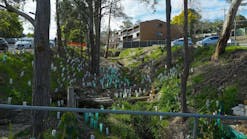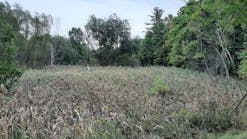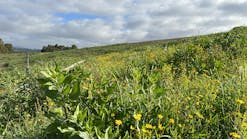No single erosion control product could prevent Minnesota’s Elm Creek from seeping over its eroding banks and onto a busy township road. So officials with the state office of the US Department of Agriculture’s Natural Resources Conservation Service (NRCS) turned instead to a menu of solutions designed to stop erosion along the creek’s banks.
The stream, which winds through Minnesota’s Martin County, had encroached to within 40 feet of a road that local schools used as a bus route. Keeping this road usable was key: If floods had forced the buses to drive along any other roads, it would have taken them significantly longer to get students to their classrooms.
To stop this erosion, the NRCS relied on a combination of solutions that included planting willow trees, installing brush mattresses, and creating a new rock-walled streambank for the creek.
How has this menu of services performed? Crews installed the erosion control measures way back in 1998. They are still protecting Elm Creek today and even survived a 2001 flood, during which more than 5 inches of rain fell in Martin County in April. That’s twice the amount of rain that typically falls in the month.
For Sonia Maassel Jacobsen, a hydraulic engineer in the St. Paul, MN, office of the NRCS, the project’s success proves the wisdom of relying on a variety of techniques to protect the waterways that run through and alongside the agency’s construction projects.
“For us, using a variety of methods is always the preference,” Maassel Jacobsen says. “When you use only one material, there is a greater chance of something going wrong. Whenever you can, it’s better to use a variety of methods. Your chances of success improve when you use a little variety.”
Maassel Jacobsen isn’t the only government or private-sector engineer who relies on this “many methods” approach when it comes to stabilizing the banks of drainage channels and other waterways and planning construction projects adjacent to them. By relying on several different types of erosion control methods, these engineers say, they are able to build more powerful defenses against erosion.
The good news is that engineers can choose from more methods than ever to protect channels and other waterways. These methods include both bioengineering techniques and manmade products.
For example, in drainage channels in which water flows only periodically-such as channels designed specifically for stormwater runoff-engineers may be able to simply line the channels with healthy vegetation. The plants will slow the flow of water, preventing soil from washing away.
Higher flow rates and a greater volume of water requires more creative methods of protection. Engineers may line waterways with geosynthetic fabrics such as turf reinforcement mats and, again, plant new vegetation. This combination provides increased protection from erosion.
In other cases, when the flow is even more powerful, engineers may add concrete protection to their arsenal of erosion control measures. Because simply lining a stream with concrete comes with several drawbacks-it doesn’t allow water, for instance, to seep into the soil-engineers may opt for a product such as articulated concrete blocks or gabions.
Not every option is appropriate for every waterway. But those engineers who are creative can find the ideal solution to their erosion control challenges by mixing and matching these possible solutions.
“As people get more educated about all the different ways you can prevent erosion, as more people take classes in these techniques, I think you’ll see even more creative solutions to erosion issues,” says Brett Troyer, head of the erosion control and turf-establishment division at the Minnesota Department of Transportation, whose department often must provide protection plans for streams and channels when it takes on road-improvement and -expansion plans.
“We’re already seeing people paying more attention to erosion,” Troyer says. “People are more aware of how important it is to protect these waterways. Now we are seeing people learn how to put erosion control methods into a plan so that those methods can be bid properly and constructed properly.”
The Elm Creek project in Martin County is a good example of the benefits of a varied approach to channel protection. Officials with the NRCS needed to shore up the creek’s banks along a 400-foot stretch.
Construction crews began the project by cutting into the stream’s existing bank and installing large pieces of rock, creating a new, hardier bank for the waterway. Crews then replaced the displaced soil and began the project’s next phase: stabilizing the area with natural vegetation.
Crews laid brush mattress-a layer of interlaced live branches cut from willow trees-along the bank’s face. They finished the project by planting a series of live willow trees above the rock and mattress to provide added stability to the creek’s banks.
The creek has held up well, and bus drivers can rumble past it without worrying about flooded roads. This success is typical of the approach the NRCS takes when tackling erosion control projects, Maassel Jacobsen says.
“We work hard to come up with things that creatively keep the streams as protected as possible,” she says. “They are often very site specific. So we don’t rule anything out as an erosion control device.”
The conservation service’s first goal in any project is to keep any water at the top of slopes. To do this, the service relies on water and sediment control basins, dikes, or other diversionary protection methods.
For long-term protection, the agency turns to products such as articulated concrete block, turf reinforcement mats, riprap, and gabions.
The agency’s engineers and planners consider several factors when deciding which erosion control measures to go with on a specific project, Maassel Jacobsen says.
“You always have to consider, of course, the ultimate purpose of a project. That will certainly guide you in which erosion control methods you are going to use,” she notes. “For instance, if you are working on a project and there’s a stream that runs close to an individual landowner, they will probably have concerns about aesthetics. They’ll want whatever you do to look nice. That has to come into play when you are picking your erosion control methods. The landowner has to be happy. Of course, it has to do the job structurally, too, so sometimes it is a balancing act.”
In situations where aesthetics is a concern, the NRCS sometimes combines bioengineering solutions with manmade products. “We like to look at the stream: Where is it going? Where does it lie in the broader floodplain? Is it a meandering stream, or is it more stable? All those factors play into our decision,” Maassel Jacobsen says.
To protect some waterways, agency engineers may call for hard-armor solutions below the channel-forming discharge point, to help keep it from the view of observers. Plans may then call for vegetated geosynthetic grids, natural vegetation, or other more visually pleasing alternatives to be placed above the hard-armor protection.
The agency even plans its placement of rock protection to provide the biggest benefit to the waterway. “There is usually a way that we can place the rocks so that we create a fish habitat,” Maassel Jacobsen says. “We can create a resting place, a corner nook, for the fish. We’ll work with biologists to create something that is mutually agreeable to everyone.”
Officials with the Missouri Department of Transportation take the same approach. John Howland, environmental studies coordinator with the department, says that his agency often must protect streams, channels, and other waterways when expanding or improving roads. This happens especially frequently when the department is replacing or building new bridges.
Like other agencies, the Missouri DOT relies on a host of products to protect its waterways. The department employs erosion control blankets, turf reinforcement mats, and natural vegetation.
But the department’s most powerful weapon against bank erosion is what it calls its Type C berm. Department officials developed this berm-made of shot rock and standing about 3 feet high-about five years ago. Crews build it parallel to waterways on the high bank with a 3:1 slope.
Howland says that the berm has become the go-to erosion control device for the department. “It’s the best tool we have,” he says. “When we used to use silt fence along the high bank adjacent to the stream, we found that it wasn’t rigid or robust enough.”
Construction vehicles would knock the silt fence over whenever they bumped against it, something that happens frequently during busy construction projects. Heavy rains would often flatten the fences, too, as would strong floodwaters.
The Type C berm, though, stands up to all this punishment, Howland says. “You have to knock these down intentionally with construction equipment or they’ll stay up indefinitely,” he says. “When we devised this tool, we put it into our specifications as a desired and preferred BMP [best management practice] in our stormwater pollution prevention plan that we need to prepare for all our Missouri Department of Transportation job sites. It goes in harmony with our NPDES [National Pollutant Discharge Elimination System] operating permits.”
The department first used its new berm six years ago along a portion of Shoal Creek near the city of Joplin, MO.
The department needed to replace an 80-year-old bridge that spanned the creek. To do this, construction crews first built a new bridge, which ran just under 200 feet long, adjacent to the old one. They then demolished the old bridge. The creek along this portion was 2 feet deep and about 30 feet wide.
The department turned to its new berm after local residents expressed concerns that the construction activity would erode the waterway and pose a threat to an endangered mussel species that lived in the creek. Engineers decided that the creek needed the extra protection that its Type C concrete berm would provide.
The berm proved effective. It ran about 100 feet on each side of the creek. Crews also installed silt fence on 90-degree angles that ran parallel to the creek’s fill slope. The stream did not suffer erosion during the process, and the berm prevented construction debris from falling into its waters.
Once construction crews finished demolishing the old bridge, they knocked down the berm and raked the rocks back, providing a hard surface to the streambank and hardening the ditches that run toward Shoal Creek.
By now, the Missouri DOT has perfected the way it uses its Type C berm. Howland says the berm works best when contractors install the structure before they start any land clearing or grubbing on the approaches of roadways. If the berm is already in place when contractors do start clearing the land, it will capture soil particles and other debris on its upper face, before these pollutants reach waterways.
The department also recommends that contractors place a layer of straw along the Type C berm to filter out the very fine soil particles that erode from the abutment. In other cases, the department advises construction crews to lay silt fence fabric along the upper face of the berm, again to keep fine materials from reaching the stream.
“We are very happy with the structure,” Howland says. “And after the project offices and project teams caught on to it, these structures began showing up on 80% of our bridge-crossing projects. They are a little pricey compared to silt fence. But excavating equipment, a trackhoe, cannot knock them down. They are not going to get blown down by a 2-inch rain. When floodwaters inundate the site, they still remain intact.”
The Minnesota DOT relies on its own variety of materials to protect the channels running through or alongside its construction projects. The department uses everything from silt fence to articulated concrete blocks to keep its waterways safe from erosion during construction projects.
Perhaps the most inventive channel-protection measure that the department uses is the plastic-lined diversion ditch that the department developed on its own. On projects that may endanger existing waterways, such as the building of culverts or bridge crossings, construction crews dig a ditch that connects to an existing waterway and then winds its way around the construction site, bypassing the work area. Construction crews then line the ditch with plastic. This keeps the stream or creek flowing if the waterway has trout or other fish passing through it.
Doing this requires that crews dam one side of the waterway and then use pumps to send the water into the temporary bypass ditch. Crews can then send the stream out of the construction site until the work is done.
In other cases, the department relies on silt fence wrapped with geotextiles to separate the work zone from a waterway. Crews have also installed articulated concrete blocks, riprap, and the occasional gabion.
Today, the department also looks for natural solutions to erosion problems. Crews may plant willows, for instance, to protect streambanks.
Troyer says that he expects the highway department to turn to natural solutions even more frequently as a growing number of landowners and neighbors seek aesthetically pleasing erosion control measures.
“We really are just starting to get into the natural materials,” he says. “We’re still developing the correct procedures for these natural products. Sometimes, still, people will argue that we don’t have to worry about using natural products, that we’re just building a road. But more people are looking for willows or natural vegetation for aesthetic reasons.”
This variety of erosion control measures is possible because manufacturers are continually creating new products. For instance, Atlanta-based CMI manufactures several varieties of vinyl sheet piling. Clients use these products to stabilize soil, as an alternative to more traditional forms of erosion control.
The pilings are especially useful, says Stacy Acton with CMI, when crews need to increase the capacity of a channel but, for whatever reason, are unable to increase the waterway’s width accordingly. The sheet pilings allow crews to build vertical structures without having to make waterways wider.
“We really are an alternative to some of the more traditional methods available,” Acton says. “We have done quite a bit of work for channel lining and embankment stabilization. We are the product contractors can turn to when they can’t make a channel wider.”
Houston-based C.E. Shepherd Co. manufactures a line of wire mesh gabions-Modular Gabion Systems-designed to keep rocks in close proximity to each other. Maury Shepherd, executive vice president of the company, says the company’s gabions are made with welded wire mesh that is protected by a proprietary fuse-bonded powder coating.
This makes the gabions suitable for work in salt water. Engineers often use the products for wetland restoration, where it is important to create a zone of undisturbed water that still needs to rise and fall with the normal tide cycles. The energy-absorbing capabilities of the gabions dissipate wave energy before it gets to the banks and disturbs any plant life used in the restoration of the wetlands.
This ingenuity is just one example of the ways in which manufacturers are continually providing new options for engineers and planners who need to battle erosion. “Gabions have been around for a long time,” Shepherd says. “But we’ve managed to improve the technology. We just improved on a good idea.”
He believes that the demand for new products will continue to grow. In large part, this is because the pace of building has been so heavy for so long; developers are converting more and more patches of water-absorbing ground into housing developments and shopping centers.
“As we build more and eliminate more of the area where the water soaks in and the pasturelands and rice fields that we’ve used to control flooding are steadily built on, we are losing some of our natural erosion control capabilities,” Shepherd says. “Erosion will become a more serious problem in areas where they’ve never had to worry about it before.”
Houma, LA-based Submar Inc. produces a line of articulated concrete revetments, mattresses, and mats. Kenneth McAllister, the company’s president, says Submar’s products offer a significant advantage over riprap and other concrete products: They can be vegetated after their installation. Water, therefore, is not simply discharged into natural areas.
“Rivers, lakes, dams, channels, creeks-anywhere you have erosion problems and a flowing water situation, you can use our products,” McAllister says.
Submar’s products are also sturdy enough to handle high velocities of water and able to support flow speeds of up to 40 feet a second. “That’s an advantage over turf mats,” McAllister notes. “A lot of turf mats can’t handle anything faster than 15 feet a second.”
When a 50-foot section of the upper deck of the eastern truss portion of the San Francisco-Oakland Bay Bridge collapsed following a 1989 earthquake, officials with the California Department of Transportation (Caltrans) knew they faced an intense rebuilding project. They had no idea, though, how much erosion control work the seismic safety project, which began in October 2001 and is scheduled to end in 2013, would require.
Construction crews are now rebuilding the entire eastern span of the busy bridge. Part of this reconstruction involves significant work where the cantilevers and suspension bridges drive through the earth at Yerba Buena Island in the bay. The potential on this rebuilding project for erosion along waterways is great, something that has inspired Caltrans officials to turn to a host of erosion control products.
“We are very committed to protecting our waterways in the state,” says Keith Jones, chief of stormwater policy and planning for Caltrans. “The potential for erosion is so great on this project that we have to be very diligent.”
To protect the water surrounding the bridge’s supports, crews have installed a host of turf reinforcement mats and erosion control blankets. Not only does Caltrans have to keep the soil stabilized, but it is also charged with re-establishing eroded land. This requires extensive revegetation to make up for the amount of native soil that construction activity disrupted.
“Our innovation on a project like this is limited only by the variety of products that we have,” Jones says. “On this project, we have faced numerous challenges from an erosion control standpoint. We’ve faced rock obstructions, mud floes, and the challenge of revegetating the land around the bridge’s anchors.”
This is far, though, from the only time that Caltrans has had to protect waterways and channels during its construction projects. The department frequently encounters temporary streams that merit protection. The state is a semi-arid environment, and streams may be wet one part of the year and dry another. These temporary waterways require erosion protection, too.
One of the keys for the department is to rely as much as possible on “green” erosion control solutions, specifically revegetating eroded areas. This is a focus that is likely to continue.
“Being that we’re the department of transportation, all of our projects are exposed to public purview,” Jones says. “Sometimes hundreds of thousands of people drive by them every day. It’s important to project the message that we are committed to doing the right thing, the green thing. People see revegetation when they look at your site, and they equate the success of that to good housekeeping. If you’re doing a good job of housekeeping, they figure, you’re doing a good job at other things.”






